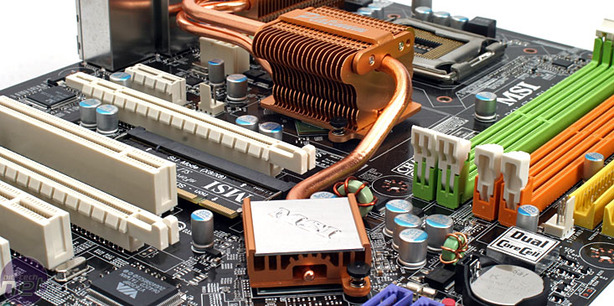Motherboard Layout
The motherboard features very typical MSI Platinum styling with a black PCB, lime green and orange DIMM sockets, copper heatsinks and white PCI slots. Why change a formula that works?There isn’t a particular theme for the board, but everything is coloured in a way that isn’t at all garish and still lets you know that every port and plug is different. The IDE ports are yellow, the SATA is purple, the Firewire pin-out is green and as I just mentioned, the memory slots are orange and lime green.
The whole board is decked out in solid aluminium capacitors apart from those that surround the sound codec, but that isn’t particularly important to the overall performance. Solid aluminium capacitors feature an “organic semi-conductive electrolyte” that increases the life and power delivery of board in general since the capacitors are often the first things to die.
The memory slots are coloured according to channel rather than according to where you should put the memory. This is a traditional MSI trait, that is different to virtually every other board on the market. Instead of putting the two sticks of memory in the same coloured slots like you would elsewhere, you now put one stick in green and one in orange, keeping the alternation.


Included is a 40mm fan for the northbridge for additional cooling. It comes with a couple of tiny thumbscrews and sits neatly over the top of the heatsink, out of the way. The downside is that this little monster runs at an incredible 8500RPM, so if you absolutely have to use it then at least attach it to a fan controller and tone down its speed and noise. Thankfully, you don't need it providing your case has some airflow, or your CPU cooler forces some air over it.
Other ports and sockets around the board are very well placed, however. The ATX power socket, both IDE ports, all four SATA ports and the pin-outs for USB and Firewire are all placed around the edges of motherboard for easy access.
There are only four SATA ports from the southbridge since this is the older nForce 430i MCP and MSI hasn’t included an extra controller for additional internal ports. There are however, two IDE sockets to provide legacy support for those who still use IDE hard drives or need to use a ton of optical drives. Both sets of IDE and SATA ports are covered by Nvidia’s MediaShield technology.
MSI does include a single eSATA port on the back of the rear I/O powered by a Silicon Image Sil3531 chipset for extra connectivity, which is a nice touch for this price range. Despite that fact this board can be had for a bit under £100, it still has plenty of different connectivity options.
Only one Gigabit Ethernet is provided by Realtek's RTLB211BL. This is a physical layer (PHY) attachment to the southbridge. It supports FirstPacket technology, but there is no Teaming support since there isn’t a complementary port.

Three PCI slots are included, of which two are still usable when SLI is enabled with dual-slot graphics cards. A single PCI-Express x1 port has also been placed above the upper most PCI-Express x16 slot so that it's always usable. The PCI-Express x16 slots have a big enough gap between them to allow for enough airflow, without having the bottom slot so close to the base of your case that your graphics card acts as a vacuum cleaner.
MSI still uses a classic mini-PCB flip method to select between SLI and non-SLI modes. This is certainly the cheaper option, but it requires you remove one or both of your graphics cards and have some nails in order to get the mini-PCB in and out.
The four USB ports pin-outs are colour coded so you know what pin plugs in where, which undoubtedly is extremely useful. However, MSI also gave the front panel pin out a very similar colour scheme and, to confuse matters further, has placed them all in the same area of the PCB. The VIA VT6308P IEEE1394a Firewire pin-out is different in that has a keyed green plastic shroud. This means you can don't need the pins colour labelled as you can only plug the supplied PCI bracket in one way.
The CMOS reset is a button instead of a jumper, which is actually far more useful than trying to fiddle about with a tiny bit of plastic in the depths of your case. Don’t do what I did though and confuse it with an on button, since it’s simply labelled “SW1” rather than the usual “CMOS”. There are no on or reset buttons onboard, but for the price and considering it’s not part of MSI's premium Diamond series, you don’t really expect it either.

MSI MPG Velox 100R Chassis Review
October 14 2021 | 15:04









Want to comment? Please log in.